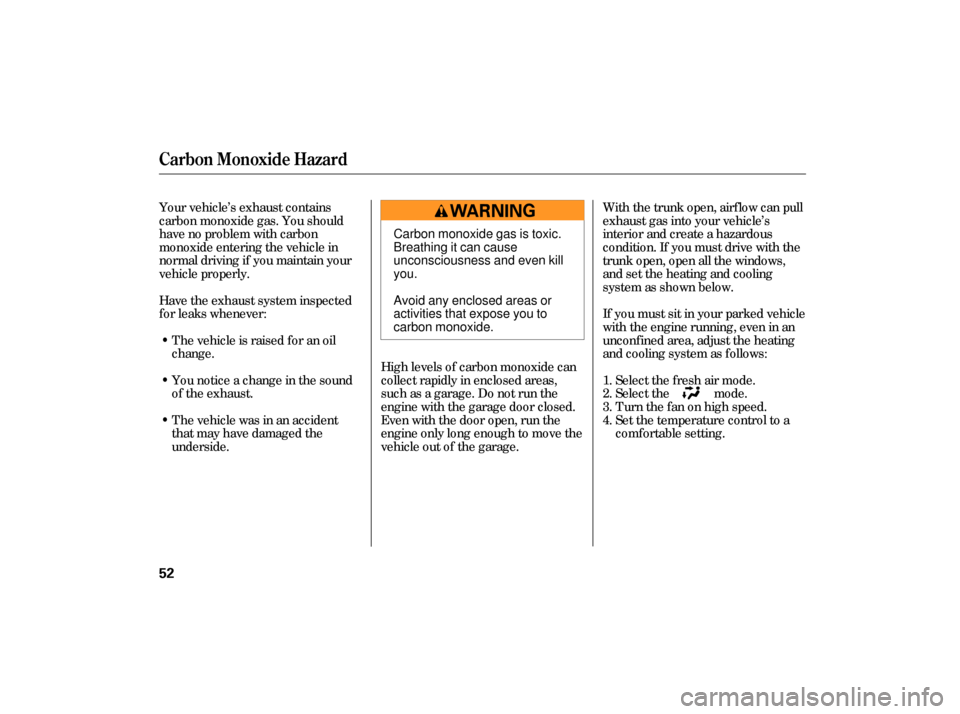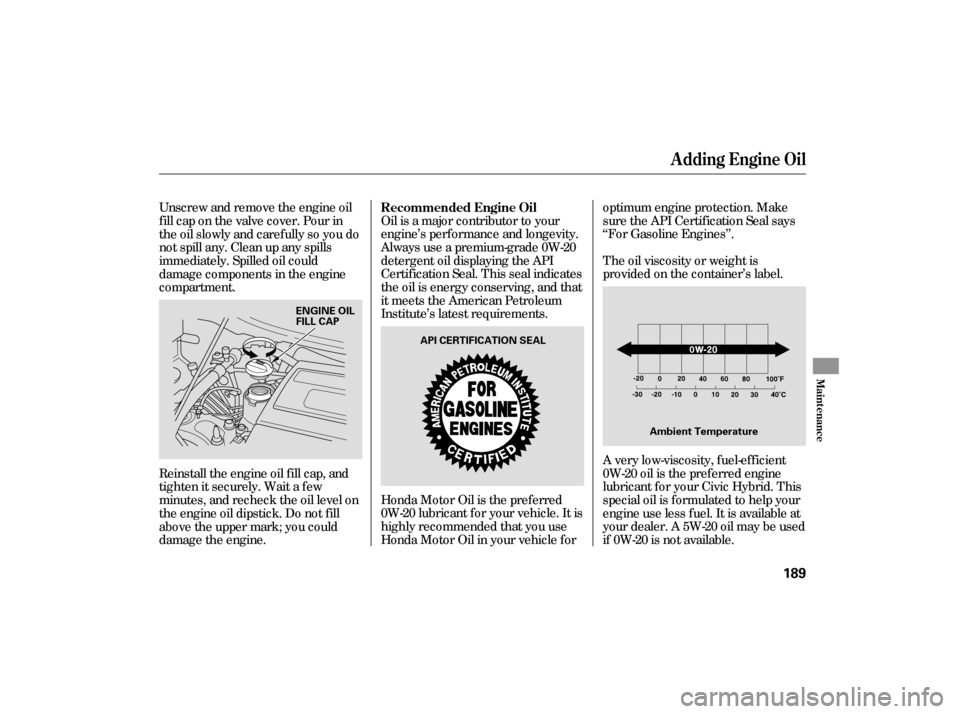Page 54 of 267

Your vehicle’s exhaust contains
carbon monoxide gas. You should
have no problem with carbon
monoxide entering the vehicle in
normal driving if you maintain your
vehicle properly.High levels of carbon monoxide can
collect rapidly in enclosed areas,
such as a garage. Do not run the
engine with the garage door closed.
Even with the door open, run the
engine only long enough to move the
vehicle out of the garage.If you must sit in your parked vehicle
with the engine running, even in an
unconf ined area, adjust the heating
and cooling system as f ollows:
Select the f resh air mode.
Select the mode.
Turn the f an on high speed.
Set the temperature control to a
comfortable setting.
The vehicle is raised f or an oil
change.
Have the exhaust system inspected
f or leaks whenever:
You notice a change in the sound
of the exhaust.
The vehicle was in an accident
that may have damaged the
underside. With the trunk open, airf low can pull
exhaust gas into your vehicle’s
interior and create a hazardous
condition. If you must drive with the
trunk open, open all the windows,
and set the heating and cooling
system as shown below.
1.
2.
3.
4.
Carbon Monoxide Hazard
52
Carbon monoxide gas is toxic.
Breathing it can cause
unconsciousness and even kill
you.
Avoid any enclosed areas or
activities that expose you to
carbon monoxide.
�����—�����—�����y�
���������
���y���
�(�#���������y���������y
Page 59 of 267

�Î
�Î
�Î
The U.S. instrument panel is shown. Differences for the Canadian models are noted in the text.
Instrument Panel
Inst ru m ent sand Cont ro ls
57
CHARGING SYSTEM
INDICATOR
SUPPLEMENTAL RESTRAINT
SYSTEM INDICATOR
TRUNK-OPEN
INDICATOR
LOW OIL PRESSURE
INDICATOR
CRUISE MAIN
INDICATOR
CRUISE CONTROL
INDICATOR
IMA SYSTEM INDICATOR HIGH BEAM
INDICATOR
LIGHT ON
INDICATOR
SECURITY SYSTEM INDICATOR
SIDE AIRBAG OFF
INDICATORDOOR-OPEN INDICATOR
WASHER LEVEL INDICATOR
ELECTRIC POWER
STEERING (EPS)
INDICATOR
Canadian model only LOW FUEL INDICATOR
MALFUNCTION INDICATOR LAMP (P. 62)
(P. 61) (P. 61)
DAYTIME RUNNING
LIGHTS INDICATOR
(P. 60)
(P. 62)
(P. 62) (P. 61)
(P. 61)
(P. 62) (P. 62) (P. 59)(P.
58)
(P.
60)
(P. 60) (P.
60)
(P. 60)
IMMOBILIZER SYSTEM
INDICATOR (P.
59) (P.
59)
(P.
63)
(P.63)
MAINTENANCE MINDER
INDICATOR
SEAT BELT REMINDER
INDICATOR (P.
61)
ANTI-LOCK BRAKE
SYSTEM INDICATOR
(P. 59)
AUTO IDLE STOP INDICATOR (P. 62) BRAKE SYSTEM
INDICATOR (AMBER)
PARKING BRAKE AND
BRAKE SYSTEM
INDICATOR (RED)(P.
58)
�����—�����—�����y�
���������
���y���
�(�#���������y���������y
Page 151 of 267
Bef ore you begin driving your
vehicle, you should know what
gasoline to use and how to check the
levels of important f luids. You also
need to know how to properly store
luggage or packages. The
inf ormation in this section will help
you. If you plan to add any
accessories to your vehicle, please
read the information in this section
first..............................
Break-in Period .150
.................
Fuel Recommendation .150
.........
Service Station Procedures .151
....................................
Ref ueling .151
OpeningandClosingthe
.......................................
Hood .152
...................................
Oil Check .153
.............
Engine Coolant Check .154
...............................
Fuel Economy .154
...
Accessories and Modif ications .156
.............................
Carrying Cargo .158
Bef ore Driving
Bef ore Driving
149
�����—�����—�����y�
����
��������y���
�(�#���������y���
�����y
Page 155 of 267
Remove the dipstick again, and
check the level. It should be
between the upper and lower
marks.
Wait
a few minutes after turning the
engine off before you check the oil.
Remove the dipstick (orange loop).
Wipe the dipstick with a clean
cloth or paper towel.
Insert it all the way back in its tube.
To
close the hood, lift it up slightly to
remove the support rod from the
hole. Put the support rod back into
its holding clip. Lower the hood to
about a foot (30 cm) above the
fender, then let it drop. Make sure it
is securely latched. If it is near or below the lower mark,
see
on page .
2.
3. 1. 4.
192
Service Station Procedures
Oil Check
A dding Engine Oil
Bef ore Driving
153
DIPSTICK UPPER MARK
LOWER MARK
SUPPORT ROD
CLIP
GRIP
�����—�����—�����y�
����
��������y���
�(�#���������y���
�����y
Page 156 of 267

Drive moderately. Rapid
acceleration, abrupt cornering,
and hard braking use more fuel.
Always drive in the highest gear
possible.
Always maintain your vehicle
according to the maintenance
schedule. See
(see page
).
an underinflated tire
causes more ‘‘rolling resistance,’’
which u ses more fuel.
Engine oil also affects fuel
economy. The fuel efficient, low-
vi scosity 0W-20 oil recommended
for your Civic Hybrid is
formulated to help the engine use
less fu el. This oil is available at
your dealer.
The build-up of snow or mud on
your vehicl e’s underside adds
weight and rolling resistance.
Frequent cl eaning helps your fuel
mileage and reduces the chance of
corrosion.
Look at the coolant level in the
radiator reserve tank. Make sure it is
between
the MAX and MIN lines. If
it is below the MIN line, see
on page .
Refer to
on page for information
about checking other items on your
vehicle. You may find that your Civic Hybrid’s
unique combination of an engine and
an electric motor has driving
characteristics that are somewhat
dif f erent f rom what you are used to.
192
184 184
For example,
Service Station Procedures, Fuel Economy
Improving Fuel Economy
Owner’s
Maintenance Checks
Engine Coolant Check
A dding
Engine Coolant
Owner’s Maintenance
Checks
154
MAX
MIN RESERVE TANK
�����—�����—�����y�
����
��������y���
�(�#���������y���
�����y
Page 186 of 267

�Ì�µ
�µ�µ
�µ
�µ �µ
U.S. Vehicles:
According to state and federal
regulations, failure to perform
maintenance on the items marked
with will not void your emissions
warranties. However, all
maintenance services should be
performed in accordance with the
intervals indicated by the
information display. Youshouldcheckthefollowing
items
at the specified intervals. If
you are unsure of how to perform
any check, turn to the appropriate
page listed.
Engine oil level Check every
time you fill the fuel tank. See
page .
Engine coolant level Check the
radiator reserve tank every time
youfillthefueltank.Seepage .
Automatic transmission Check
the fluid level monthly. See page
.
Brakes Check the fluid level
monthly. See page .
Tires Check the tire pressure
monthly. Examine the tread for
wear and foreign objects. See page
. Lights
Check the operation of
the headlights, parking lights,
taillights, high-mount brake light,
and license plate lights monthly.
See page .
153 154
195 196
207 197
Maintenance Minder
Maintenance,
replacement, or repair of
emissions control devices and
systems may be done by any
automotive repair establishment
or individual using parts that are
‘‘certif ied’’ to EPA standards. Owner’s Maintenance Checks
184
�����—�����—�����y�
������
������y���
�(�#���������y���
�����y
Page 187 of 267

�Ì�Ì
�Ì
Maintenance Minder
185
: Maintenance
Sub Items
Rotate tires
Replace air cleaner element
If you drive in dusty conditions, replace
every 15,000 miles (24,000 km).
Replace dust and pollen filter
If you drive primarily in urban areas that have high
concentrations of soot in the air from industry and
from diesel-powered vehicles, replace every 15,000
miles (24,000 km).
Inspect drive belt
Replace transmission fluid
Replace spark plugs
Inspect valve clearance
Replace engine coolant
Maintenance
Main Items
Replace engine oil
Replace engine oil and oil filter
Inspect front and rear brakes
Check parking brake adjustment
Inspect these items:
Tie rod ends, steering gear box, and boots
Suspension components
Driveshaft boots
Brake hoses and lines (including ABS)
All fluid levels and condition of fluids
Exhaust system
Fuel lines and connections
A
B
Symbol
Symbol
1
2
3
4
5
If the message ‘‘SERVICE OIL’’ does not appear more than 12 months after
the display is reset, change the engine oil every year.
See information on maintenance and emissions warranty on page .
Independent of the maintenance minder display, replace the brake fluid
every 3 years.
Inspect idle speed every 160,000 miles (256,000 km).
Adjust the valves during services A, B, 1, 2, or 3 only if they are noisy.
NOTE:
185
1:
1
1
Maintenance Minder
�����—�����—�����y�
������
��
�
�y���
�(�#���������y���
�����y
Page 191 of 267

The oil viscosity or weight is
provided on the container’s label.
Oil is a major contributor to your
engine’s perf ormance and longevity.
Always use a premium-grade 0W-20
detergent oil displaying the API
Certif ication Seal. This seal indicates
the oil is energy conserving, and that
it meets the American Petroleum
Institute’s latest requirements.
Honda Motor Oil is the pref erred
0W-20 lubricant f or your vehicle. It is
highly recommended that you use
Honda Motor Oil in your vehicle f or optimum engine protection. Make
sure the API Certif ication Seal says
‘‘For Gasoline Engines’’.
A very low-viscosity, f uel-ef f icient
0W-20 oil is the pref erred engine
lubricant f or your Civic Hybrid. This
special oil is f ormulated to help your
engine use less fuel. It is available at
your dealer. A 5W-20 oil may be used
if 0W-20 is not available.
Unscrew and remove the engine oil
fill cap on the valve cover. Pour in
the oil slowly and caref ully so you do
not spill any. Clean up any spills
immediately. Spilled oil could
damage components in the engine
compartment.
Reinstall the engine oil f ill cap, and
tighten it securely. Wait a f ew
minutes, and recheck the oil level on
the engine oil dipstick. Do not f ill
above the upper mark; you could
damage the engine. Recommended Engine Oil
A dding Engine Oil
Maint enance
189
API CERTIFICATION SEAL
ENGINE OIL
FILL CAP
Ambient Temperature
�����—�����—�
���y�
������
������y���
�(�#���������y���
�����y